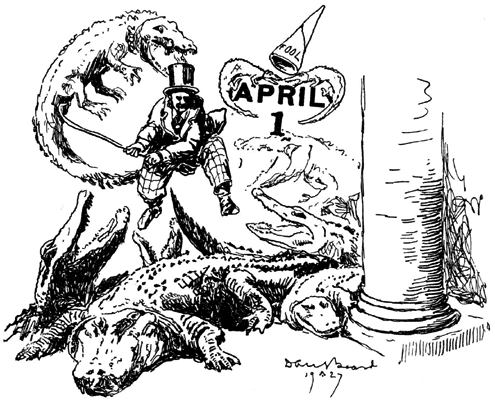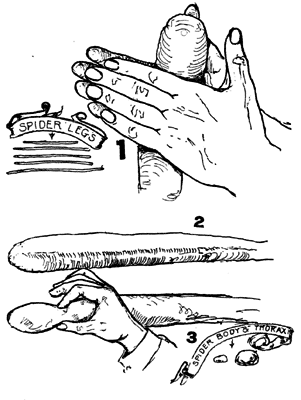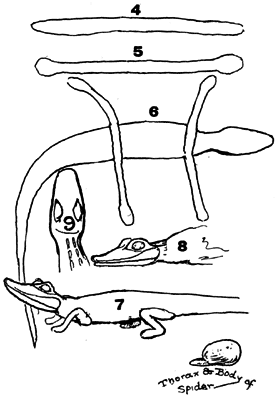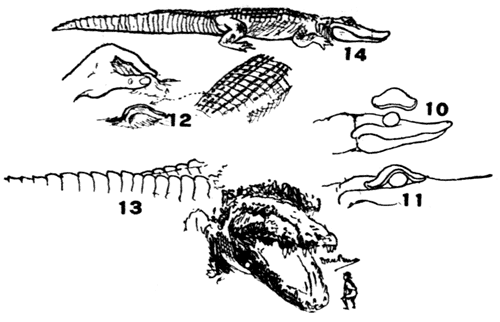[Trade Journal]
Publication: Boys' Life
New York, NY, United States
vol. 17, no. 4, p. 29, 51, col. 1-3,2
April Fool's Day "Gators"
By Dan Beard
Illustrated by the Author
LIKE many other celebrities, April Fool's Day, of course, dates back to the heathen or pagan times, but that does not interest the boys so much as does the fun of the day itself. On the first of April vicious boys, means fellows, after the manner of their kind, always did and always will pull off mean and vicious stunts, which is not at all according to the tradition of the day, for to quote from an old English book it is said of April that
Its life is one sweet alternation of smiles and sighs and tears,
And tears and sighs and smiles, till it is consummated at last in the open laughter of May!
March is Kite Time and April used to be Blow Gun Time. On or about the first of April, the boys went to the tin shop and had their pea shooters, or putty shooters, as they are called in the East, made to order or they took the trail to the river bank where the Hemingray Glass Works stood and had long glass blow-guns made for them by one of the accommodating glass-blowers. The only trouble with the glass blow-gun lies in the fact that it is soon broken.
Of course, when one of the River Rats acquired a blow-gun by robbing some small boy, he would invent some more or less mean trick to play with it. From his vantage on the roof of a barn in a back alley, one of them saw a big pan of hot custard cooling on a shelf outside the back window of a boarding house. Ever since the time of the flood when legends say Noah stopped at the house for lunch, that great pan of custard was always placed on the window shelf on Wednesdays to cool. Now it so happened that this River Rat had found, or stolen, a box of pills. Let us hope that he did not know for what use the pills were made, but he did discover that they exactly fit his blow-gun.
The River Rat was a good shot and from his perch on the roof of the barn he succeeded in landing almost every one of the pills into the hot custard; fortunately the pills were not dangerous.
It is passing strange, but never again did they serve custard at that boarding-house! By some unknown means, a few weeks later, the secret leaked out and the news became general gossip. Possible the River Rat foolishly boasted of his marksmanship. It was a mean trick and might have been a tragic one; nevertheless, everybody except the boarders seemed to think it funny; but when the secret became public, blow-guns became so unpopular in that neighborhood that it was not safe for any boy, no matter how good his reputation might be, to be seen carrying one. Consequently, the boys had to find other uses for the blue clay, which had been used exclusively for ammunition, until the advent of the box of pills had produced an unwritten law against having blow-guns in one's possession.
But the boys made little clay bowls and dishes, crudely modeled, which they dried and baked in their campfires on the river bank, and some of the lads developed considerable skill in modeling all sorts of creatures in clay. It must be said that most of the things they modeled, however, resembled the pre-historic monsters which have been of late discovered by the scientific expositions to the Gobi desert and other interesting and fascinating places, than they did any living creatures. But when it came to making alligators the boys were in their element, and they made them so well that they never failed to deceive the grown people.
 |
Of course, this deception may have been largely due to the woeful lack of knowledge, on the part of the grown-ups, as to the real appearance of these reptiles, for the dried blue clay is bluish gray in color, not brownish yellow like real alligators; however, since the grown-ups were deceived, it is only fair to give the boys credit for exercising some genius in modeling. The statues they made, it must be confessed, resembled Pagan idols more than they did the classic Greek; but however terror-inspiring the clay saurians might have been on the first of April, 1862, unlike the classic Greek statues, no one noticed their lack of clothes.
AFTER the gentlemen had finished their breakfast and were starting to business, they were shocked and horrified to find half-grown specimens of crocodilidae sprawling on their front door-steps. When one man in particular opened his front door and saw the monster reposing on the steps he hurriedly reentered the house and slammed the door; then came stealthily back with a heavy cane and commenced to beat the poor unoffending mud image with it. The fact that the first blow broke the creature in half, apparently did not seem strange to this gallant gentleman, for carefully keeping out of range of the terrible jaws, and the flail-like tail, he literally beat the model into fragments and then walking carefully around it, as if in fear that the fragments might jump at him, he went on his way, head up and chest out, conscious of having performed a brave and gallant act.
 |
The boys also modeled very large spiders out of "Touloo" chewing gum; they made the spiders adhere to the door jambs. These-ferocious spiders were painted most brilliant hues with colored chalk, and like the alligator completely duped the innocent victims, so that without exception they were beaten to pieces. Having cooled off, the chewing-gum became hard and brittle, and like the other terrifying hobgoblin creature it also fell in fragments when struck. But grown people seemed to have forgotten what they all knew as boys and girls, and their suspicions were not aroused when the spider broke to pieces, nor surprised at the brittleness of the arthropod,* and seemed to think that that was a characteristic of that particular kind of an arachanidan,* much to the glee of Sandy Bar and Monkey Sholes.
The lads not only deceived the grown people but they also made victims of the other boys, all of which showed the lamentable general lack of knowledge in nature history in those days. But when Professor Worrall discovered, after school had opened, an awe-inspiring gorgeous spider on his desk, he did not smash it to pieces. He looked at it carefully, then he took a big magnifying glass and examined it; then he smiled, rapped on his desk with his rattan and called for the culprit to come forward and center, but in place of chastising the frightened lad or lecturing him, he complimented him on the excellency of his work.
 |
If any of you boys think you could have done the work as well as the boys of yesterday, you should try your hand at modeling. Take clay, damp enough to make it about the consistency of putty; in other words, soft enough to work and model and not wet enough to stick to one's hands. Select a hunk and roll it between your hands, figure 1, or put it on a smooth board and roll it under your hands, as is the most convenient. Of course, if you are modeling a big reptile it had better be rolled under both hands on a table top until it assumes the shape and form of figure 2.
To make the head pinch its neck with your fingers, figure 3, so as to make the neck smaller than the head or the body. The neck on the big old grandfather alligators is not small like it is on the younger reptiles; but we are making a middle-aged "gator" so we'll make the neck a bit smaller. To make the legs roll a piece of clay between your hands until it assumes the form of figure 4; then pinch the ends flat for the feet like figure 5; next, turn the "gator" over on his back and push the legs on until they stick, figure 6; after that you bend the legs up at the knees and down at the heels as in figure 7.
 |
THE head of the alligator, figures 8 and 9, is modeled into shape with one's fingers and then two little pellets of clay are put on for eyes, figure 10, and over the eyes another little piece of clay is plastered, figure 11. That will give the effect of figures 7 and 8. On young alligators the eye is very prominent, almost, if not quite, as that of a frog; but the old fellows, as may be seen by the head shown next to figure 13, have eyes which are not so prominent. We will, however, stick to the younger type and make the middle-aged alligator shown in figure 14.
To make the ridges, which look like sawteeth on the alligator's tail and back, it is only necessary to pinch the clay between one's fingers, as in figure 12. The number and the arrangement of the "saw-teeth," on the middle of the back are shown in the back view, figure 15. On the taifend of the tail, so to speak, there is only a single ridge, figures 15 and 16. Figure 17 shows the hind foot and figure 18 the front foot.
To make the mouth, take a flat-bladed knife and cut back beyond the eyes, as shown in figures 7, 8 and 14. Open the mouth, then round off the edge of the gums by running your finger along and close the mouth again. Figures 10 and 14 show the proper curve to the back of the jaw, which is easily made after you have opened the mouth and before you close it.
Of course, it is not necessary in making a crude model to make the feet so carefully. One may use a knife to cut the toes apart and then model them with one's fingers and make the front feet like a hand; but if you are going to make a "gator" you might as well make it correctly, as in figures 17 and 18.
NOW, then, put your alligator on a board somewhere and let it dry. If you have produced a real work of art, of which you are proud, when it is thoroughly dry, it may be baked in a hot fire and transformed into an earthenware model. But there are various other clays that are better suited for baking purposes than blue clay. We used blue clay because we could always secure a supply wherever we found men at work digging a cellar, for be it known that the circular valley in which Cincinnati, Newport and Covington are located seems to have been built on the order of a layer cake. Even the hills are layers of limestone, some of them composed entirely of the most charming and interesting fossils, petrified shells, petrified stone lilies, and, of the most interesting of all petrified trilobites. If you don'f know what these things are, look for them in your geology, for this is not a story about fossils, unless you live in Tennessee!
There were two groups in that valley, however, that were not petrified. One was the River Rats, although some folks thought that they would be much more charming and interesting as fossils than they were as live under-privileged boys. The other group was Monkey Sholes, Sandy Bar, Lerdom, and the rest of the gang. Both groups were live wires and sometimes pretty hot wires at that.
I almost forgot to tell you that the scale-like markings on the "Jacare," Caiman or "gator," can be traced with a pointed stick.
It is not recorded that any of the boarders were seen grinning, smiling or laughing on April the first — I mean the inmates of the house where they served the custard on Wednesdays — and I fear that had they discovered the villain who played the trick on them it would have been a sorry and a painful experience for the boy. But the tricks that Monkey Sholes, Sandy Bar, Lerdom, and the rest of the Boone Scouts played were all of them harmless; and made even the victims laugh after their first embarrassment was over.
* Never mind the high-hat words. I had to use them 'cause I couldn't say "spider" so often.
